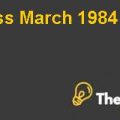
- Background
The report presents a case about General Motors Corporation, which was incorporated in 1908. The company had specialization in the production of cars and trucks in around 34 countries with a cumulative workforce of around 209,000 peoples worldwide. It has a business in nearby 140 countries, which made General Motors (GM) the world’s second largest automotive industry.
General Motors (GM) have enjoyed tremendous success over the last few years but the financial crises in late 2008 deteriorated the financial position of the company significantly and made them to report a loss of $30.9 billion in December 2008 and its liabilities were $176.1 billion against its assets of $91.0 billion. Later on, the company failed to operate its operations and such events led them to file bankruptcy under the aegis of the US Federal Government.
As part of its bankruptcy proceedings, General Motors (GM) was considering the future of one of its subsidiaries Opel, which had seven plants in Western Europe and had a total workforce of around 48,000, half of which were in Germany. Ople-Vauxhall’s assets had been placed as part of bankruptcy proceedings in a separate trust so as to reduce its stake at Opel to a minority, which would enable a minority shareholder to come abroad and restructure the loss making subsidiary. In this respect, the company obtained bids from three automobile buyers that include Fiat, Magna and RHJI.
- Stakeholders of General Motors
- a. Potential Buyers:
Three potential buyers were approaching General Motors (GM) to sale its stake in Opel that consist of Fiat, Magna and RHJI. Fiat had bid for the combine GM’s European division with the vision to create the world’s second largest company behind Toyota Japan.
General Motors (GM) had an ongoing relation with Magna as the latter’s biggest customer and the company was scrutinizing joint bid for Opel with Russia’s largest credit institution , Sberbank. Magna was considering to acquire Opel with a vision to use Opel’s plants in Europe to build vehicle for other carmakers.
RHJ International was a diversified company with an intention to increase the value of shareholders by acquiring and operating businesses. RHJI had made a very formal outlook of the prospective investment and had clear-cut vision for the restructuring of the company.
- b. Government:
The financial crises in late 2008 deteriorated the buying capability of the consumers, which significantly hit the sales of cars. As, the auto industry was a major source of economic growth and job creation, so the government of many countries supported auto industries so as to strengthen their position and boost the economic condition. As long as Magna signs a non-binding agreement with General Motors (GM), the German Government has provided a loan of €1.5 billion to General Motors (GM) and has also agreed to provide a further loan of €4.5 billion to Magna towards the restructuring of Opel. This increased the interest of German Government in the deal and it was considering to finalize the deal, which would benefit the whole economy.
- c. Employees:
Employees are major stakeholders of the company because they are influenced by the action of the company. General Motors (GM) is running through a tough phase because its survival has been questioned due to the financial crises in 2008, so the organization is considering to restructure its operations, which will lead to cut jobs of many employees, hence, deteriorating their right. German Government has made an initiative to provide €1.5 billion to GM to increase the attractiveness of the deal and to strengthen the economy of the country.
Strategic Perspective
The strategic perspective of the management of General Motors (GM) is to expand the operations of the company by investing in new markets. The financial crises in late 2008 deteriorated the financial situation of the company, which led them to take difficult decision to divest its shareholding in Opel.
The strategic perspective of General Motors (GM) is to retain Opel in the long run even if it means letting it go in the short run. This is because Opel is the long lasting subsidiary of General Motors (GM) from 1929 and they do not wish to spoil their relation. Further, the management does not wish to divest its share in Opel because of IPR as General Motors (GM) hold the rights to Opel’s engine technology. Additionally, Opel had the technology of mid-sized vehicles, which was a growing customer segment in North America and Europe. If GM divests the share in Opel then it will lose the Instinctual Property Rights (IPR) and it will also lose the mid-sized technology that will significantly deteriorate the market share of the company and the company may result in further losses. Moreover, the company can also co-ordinate with potential buyers so as to retain the rights.
Problem Identification
The management was concerned about the financial crises in 2008, which threatened the profits of General Motors (GM) substantially and made them to report a loss of $30.9 billion in 2008 and their liabilities were amounting to $176.1 billion .................
This is just a sample partial case solution. Please place the order on the website to order your own originally done case solution.












